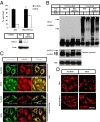Activation of mitochondrial protease OMA1 by Bax and Bak promotes cytochrome c release during apoptosis
- PMID: 25275009
- PMCID: PMC4205663
- DOI: 10.1073/pnas.1417253111
Activation of mitochondrial protease OMA1 by Bax and Bak promotes cytochrome c release during apoptosis
Abstract
Intrinsic apoptotic stimuli initiate mammalian cells' apoptotic program by first activating the proteins that have only Bcl-2 homology domain 3 (BH3), such as Bcl-2 interacting mediator of cell death (Bim) and truncated BH3 interacting death domain agonist (tBid), which in turn trigger conformational changes in BCL2-associated X (Bax) and BCL2-antagonist/killer (Bak) proteins that enable oligomer formation on the mitochondria, causing cytochrome c and other apoptogenic proteins in the intermembrane space to leak out. Leaked cytochrome c then initiates apoptotic caspase activation through a well-defined biochemical pathway. However, how oligomerized Bax and Bak cause cytochrome c release from mitochondria remains unknown. We report here the establishment of cell lines in which Bim or tBid can be inducibly expressed to initiate apoptosis in a controlled, quantitative manner. We used these cell lines to examine apoptotic events after Bax and Bak oligomerization but before cytochrome c release. The mitochondrial metalloprotease OMA1 was activated in this system in a Bax- and Bak-dependent fashion. Activated OMA1 cleaved the dynamin-like GTPase, optical nerve atrophy 1, an event that is critical for remodeling of mitochondrial cristae. Knockdown or knockout of OMA1 in these cells attenuated cytochrome c release. Thus it is clear that oligomerized Bax and Bak trigger apoptosis by causing both the permeabilization of the mitochondrial outer membrane and activation OMA1.
Keywords: Smac; caspase; membrane potential; permeability.
Conflict of interest statement
The authors declare no conflict of interest.
Figures





References
-
- Liu X, Kim CN, Yang J, Jemmerson R, Wang X. Induction of apoptotic program in cell-free extracts: Requirement for dATP and cytochrome c. Cell. 1996;86(1):147–157. - PubMed
-
- Li P, et al. Cytochrome c and dATP-dependent formation of Apaf-1/caspase-9 complex initiates an apoptotic protease cascade. Cell. 1997;91(4):479–489. - PubMed
-
- Du C, Fang M, Li Y, Li L, Wang X. Smac, a mitochondrial protein that promotes cytochrome c-dependent caspase activation by eliminating IAP inhibition. Cell. 2000;102(1):33–42. - PubMed
-
- Verhagen AM, et al. Identification of DIABLO, a mammalian protein that promotes apoptosis by binding to and antagonizing IAP proteins. Cell. 2000;102(1):43–53. - PubMed
-
- Kluck RM, Bossy-Wetzel E, Green DR, Newmeyer DD. The release of cytochrome c from mitochondria: A primary site for Bcl-2 regulation of apoptosis. Science. 1997;275(5303):1132–1136. - PubMed
Publication types
MeSH terms
Substances
LinkOut - more resources
Full Text Sources
Other Literature Sources
Molecular Biology Databases
Research Materials

